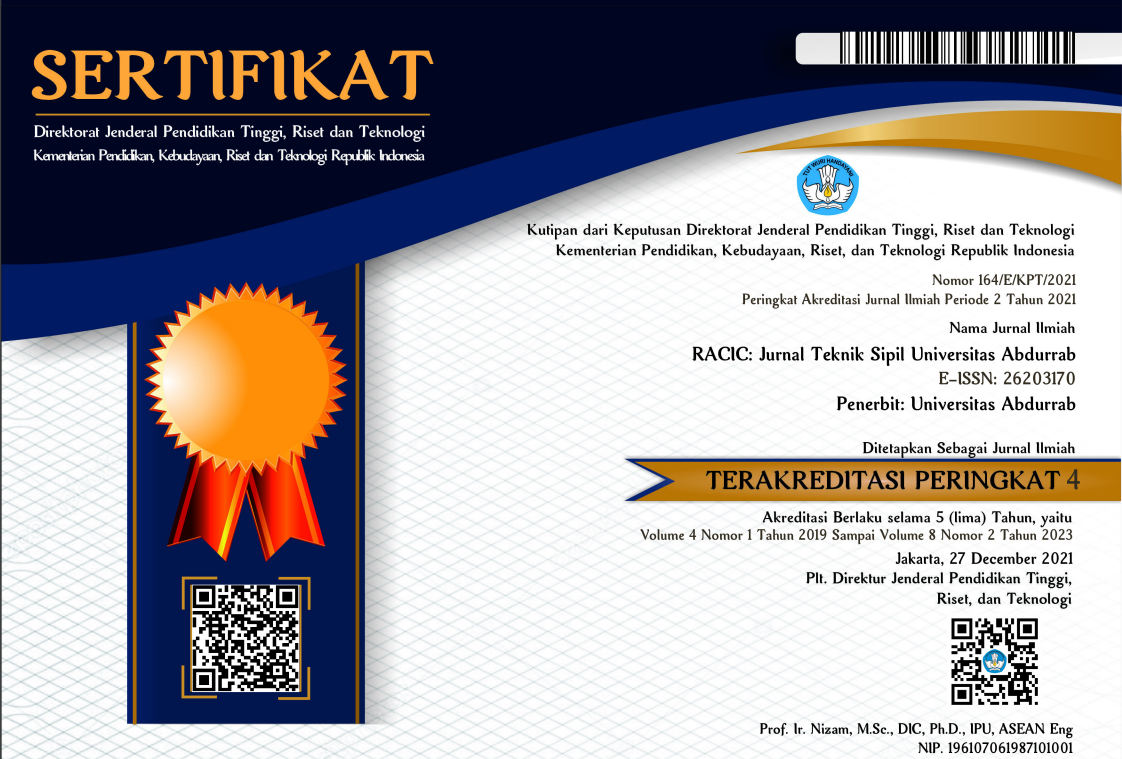ANALISIS RISIKO KERJA PADA PROYEK PEMBANGUNAN BANDARA
DOI:
https://doi.org/10.36341/racic.v9i1.4071Kata Kunci:
Analisis Risiko, Hazard Identification and Risk Assessment, Fault Tree AnalysisAbstrak
Risiko merupakan suatu peristiwa yang mengakibatkan kerugian baik secara fisik maupun materi. Perusahaan yang terlibat dalam suatu pembangunan proyek harus menerapkan program keselamatan dan kesehatan kerja. Meskipun tidak dapat dipungkiri bila masih terjadi beberapa kecelakaan kerja yang disebabkan oleh berbagai faktor, sehingga penelitian ini bertujuan untuk menganalisis risiko kecelakaan kerja pada proyek. Analisis risiko pada penelitian ini dilakukan dengan menggunakan dua metode. Pada metode pertama perlu dilakukan identifikasi jenis kecelakaan kerja menggunakan metode Hazard Identification and Risk Assessment (HIRA) dimulai dengan survei berupa penyebaran kuesioner kepada responden untuk mengetahui nilai serevity (tingkat keparahan) dan probability (kemungkinan) bagi masing - masing variabel agar diketahui risiko terbesar. Setelah diidentifikasi didapat 6 variabel risiko besar dan salah satu diantaranya yaitu pada aktivitas mobilisasi/demobilisasi alat berat dan kendaraan material yang diidentifikasi memiliki bahaya pembebanan struktur dengan kecelakaan kerja yang paling buruk ialah dump truck terperosok saat melintasi struktur yang tidak dapat menahan beban. Setelah ditemukan bahaya dengan risiko terbesar kemudian dicari faktor penyebab risiko tersebut menggunakan metode kedua yaitu, Fault Tree Analysis (FTA) dimana risiko tersebut disebabkan oleh 3 faktor yaitu faktor manusia, faktor manajemen, dan faktor lingkungan. Ditemukan 11 penyebab dasar dengan kombinasi minimal cut set menghasilkan 7 kombinasi penyebab dasar (basic event).
Kata Kunci: Analisis Risiko, Hazard Identification and Risk Assessment, Fault Tree Analysis
Unduhan
Referensi
Amelia (2018) “Analisis Beban Kerja Fisik Dan Tingkat Kelelahan Kerja Secara Ergonomis Terhadap Karyawan Pt. Berkat Karunia Phala Duri," Analysis of Physical Workload and Work Fatigue Level Ergonomics at,†Jom Feb, 1(1), hal. 1.
Badraningsih dan Zuhny, E. (2017) “Kecelakaan Akibat Kerja dan Penyakit Akibat Kerja,†in Environmental Pollution, hal. 120–8.
Kristianti, I. dan Tualeka, A.R. (2019) “Hubungan Safety Inspection Dan Pengetahuan Dengan Unsafe Action Di Departemen Rolling Mill,†The Indonesian Journal of Occupational Safety and Health, 7(3), hal. 300. https://doi.org/10.20473/ijosh.v7i3.2018.300-309.
Menteri Perhubungan (2013) “Peraturan Menteri Perhubungan No 69 Tahun 2013 Tentang Tatanan Kebandarudaraan Nasional,†Kementrian Perhubungan Republik Indonesia, 65(1046), hal. 1–15.
Pasaribu, H.P., Setiawan, H. dan Ervianto, W.I. (2017) “Metode Failure Mode and Effect Analysis (FMEA) dan Fault Tree Analysis (FTA) Untuk Mengidentifikasi Potensi dan Penyebab Kecelakaan Kerja Pada Proyek Gedung,†Manajemen Teknik.
Permen PUPR No.21 (2019) “Permen PUPR No.21,†Pedoman Sistem Manajemen Kesehatan Konstruksi, (1), hal. 1–25. http://www.pu.go.id/.
Putri, R.N. dan Trifiananto, M. (2019) “Analisa Hazard Identification Risk Assessment and Risk Control (HIRARC) Pada Perguruan Tinggi yang Berlokasi Di Pabrik,†Seminar dan Konferensi Nasional IDEC, hal. 2–3.
Restuputri, D.P. dan Sari, R.P.D. (2019) “Analisis Kecelakaan Kerja dengan menggunakan Metode Hazard and Operability Study (HAZOP) (Studi Kasus: PT. XYZ),†Jurnal Teknik Industri Terintegrasi, 2(2), hal. 30–37. https://doi.org/10.31004/jutin.v2i2.480.
Roehan, K.R.A., Yuniar dan Desrianty, A. (2014) “Usulan Perbaikan Sistem Manajemen Keselamatan dan Kesehatan Kerja (SMK3) Menggunakan Metode Hazard Identification and Risk Assesment (HIRA) *,†Jurnal Online Institut Teknologi Nasional, 02(02).
Servanio (2012) “Analisis Penyebab Keterlambatan Pada Proyek Pembangunan Gedung Kandang Hewan Fakultas Kedokteran Unair C Surabaya Menggunakan Metode Fault Treeanalysis (Fta),†Universitas 17 Agustus 1945 Surabaya, 1(1), hal. 1–21.
##submission.downloads##
Diterbitkan
Terbitan
Bagian
Lisensi
1. Copyright of all journal manuscripts is held by the RACIC : Rab Construction Research
2. Formal legal provisions to access digital articles of electronic journal are subject to the provision of the Creative Commons Attribution-ShareAlike license (CC BY-NC-SA), which means that RACIC : Rab Construction Research is rightful to keep, transfer media/format, manage in the form of databases, maintain, and publish articles.
3. Published manuscripts both printed and electronic are open access for educational, research, and library purposes. Additionally, the editorial board is not responsible for any violations of copyright law.
licensed under a Creative Commons Attribution-ShareAlike 4.0 International License.





